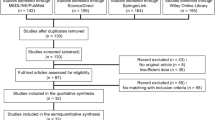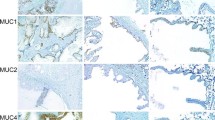Abstract
Polymorphous low grade adenocarcinoma (PLGA) is a tumor of minor salivary glands that exhibits considerable morphologic overlap with adenoid cystic carcinoma and cellular pleomorphic adenoma, especially in small biopsy specimens. Unlike these other tumor types. PLGAs do not harbor a myoepithelial component, yet their frequent positivity for p63 diminishes the usefulness of this particular myoepithelial marker as a discriminating immunostain. p40 is an antibody that recognizes ΔNp63, a p63 isoform that is more specific for true myoepithelial differentiation. As such, p40 immunostaining could help distinguish PLGAs from adenoid cystic carcinomas and pleomorphic adenomas. In this study, p63 and p40 immunohistochemistry was performed on paraffin embedded, formalin fixed tissue from 11 PLGAs, 101 adenoid cystic carcinomas, and 31 pleomorphic adenomas. All 11 PLGAs (100 %) were positive for p63 but completely negative for p40. Among adenoid cystic carcinomas, 91 of 101 (90 %) were positive for p63 and 90/101 (89 %) were positive for p40. The single discordant p63+/p40− adenoid cystic carcinoma exhibited solid architecture and high grade features not typically seen in PLGA. Among pleomorphic adenomas, 21/31 (68 %) were positive for p63 and 13/31 (42 %) were positive for p40. For the pleomorphic adenomas, the discordant p63+/p40− staining pattern was seen only in the overtly mesenchymal chondromyxoid stroma. The cellular epithelial component of the pleomorphic adenomas demonstrated concordant p63+/p40+ or p63−/p40− immunophenotypes. PLGA consistently exhibits a p63+/p40− immunophenotype that can help distinguish it from adenoid cystic carcinoma and cellular pleomorphic adenoma, tumors that characteristically demonstrate concordant p63 and p40 immunostaining patterns. A p63/p40 immunohistochemical panel can provide a valuable tool for making the distinction between these morphologically similar but clinically divergent entities.


Similar content being viewed by others
References
Luna MA, Wenig BM. Polymorphous low-grade adenocarcinoma. In: Barnes L, Eveson JW, Reichart P, Sidransky D, editors. Pathology and genetics of head and neck tumours. Lyon: IARC Press; 2005. p. 223–4.
Ellis GL, Auclair PL. Polymorphous low-grade adenocarcinoma. AFIP atlas of tumor pathology: tumors of the salivary glands. Washington, DC: ARP Press; 2008. p. 246–259.
Frierson HF Jr, Mills SE, Garland TA. Terminal duct carcinoma of minor salivary glands. A nonpapillary subtype of polymorphous low-grade adenocarcinoma. Am J Clin Pathol. 1985;84:8–14.
Aberle AM, Abrams AM, Bowe R, et al. Lobular (polymorphous low-grade) carcinoma of minor salivary glands. A clinicopathologic study of twenty cases. Oral Surg Oral Med Oral Pathol. 1985;60:387–95.
Venkata V, Irulandy P. The frequency and distribution pattern of minor salivary gland tumors in a government dental teaching hospital, Chennai, India. Oral Surg Oral Med Oral Pathol Oral Radiol Endod. 2011;111:e32–9.
Kakarala K, Bhattacharyya N. Survival in oral cavity minor salivary gland carcinoma. Otolaryngol Head Neck Surg. 2010;143:122–6.
Pires FR, Pringle GA, de Almeida OP, et al. Intra-oral minor salivary gland tumors: a clinicopathological study of 546 cases. Oral Oncol. 2006;43:463–70.
Castle JT, Thompson LD, Frommelt RA, et al. Polymorphous low grade adenocarcinoma: a clinicopathologic study of 164 cases. Cancer. 1999;86:207–19.
Gnepp DR, S el-Mofty. Polymorphous low-grade adenocarcinoma: glial fibrillary acidic protein staining in the differential diagnosis with cellular mixed tumors. Oral Surg Oral Med Oral Pathol Oral Radiol Endod. 1997;83:691–5.
Loducca SV, Raitz R, Araujo NS, et al. Polymorphous low-grade adenocarcinoma and adenoid cystic carcinoma: distinct architectural composition revealed by collagen IV, laminin and their integrin ligands (alpha2beta1 and alpha3beta1). Histopathology. 2000;37:118–23.
Araujo VC, Loducca SV, Sousa SO, et al. The cribriform features of adenoid cystic carcinoma and polymorphous low-grade adenocarcinoma: cytokeratin and integrin expression. Ann Diagn Pathol. 2001;5:330–4.
Curran AE, White DK, Damm DD, et al. Polymorphous low-grade adenocarcinoma versus pleomorphic adenoma of minor salivary glands: resolution of a diagnostic dilemma by immunohistochemical analysis with glial fibrillary acidic protein. Oral Surg Oral Med Oral Pathol Oral Radiol Endod. 2001;91:194–9.
Darling MR, Schneider JW, Phillips VM. Polymorphous low-grade adenocarcinoma and adenoid cystic carcinoma: a review and comparison of immunohistochemical markers. Oral Oncol. 2002;38:641–5.
Edwards PC, Bhuiya T, Kelsch RD. C-kit expression in the salivary gland neoplasms adenoid cystic carcinoma, polymorphous low-grade adenocarcinoma, and monomorphic adenoma. Oral Surg Oral Med Oral Pathol Oral Radiol Endod. 2003;95:586–93.
Penner CR, Folpe AL, Budnick SD. C-kit expression distinguishes salivary gland adenoid cystic carcinoma from polymorphous low-grade adenocarcinoma. Mod Pathol. 2002;15:687–91.
Epivatianos A, Iordanides S, Zaraboukas T, et al. Adenoid cystic carcinoma and polymorphous low-grade adenocarcinoma of minor salivary glands: a comparative immunohistochemical study using the epithelial membrane and carcinoembryonic antibodies. Oral Dis. 2005;11:175–80.
Woo VL, Bhuiya T, Kelsch R. Assessment of CD43 expression in adenoid cystic carcinomas, polymorphous low-grade adenocarcinomas, and monomorphic adenomas. Oral Surg Oral Surg Oral Med Oral Pathol Oral Radiol Endod. 2006;102:495–500.
Beltran D, Faquin WC, Gallagher G, et al. Selective immunohistochemical comparison of polymorphous low-grade adenocarcinoma and adenoid cystic carcinoma. J Oral Maxillofac Surg. 2006;64:415–23.
Curran AE, Allen CM, Beck FM, et al. Distinctive pattern of glial fibrillary acidic protein immunoreactivity useful in distinguishing fragmented pleomorphic adenoma, canalicular adenoma and polymorphous low grade adenocarcinoma of minor salivary glands. Head Neck Pathol. 2007;1:27–32.
Epivatianos A, Poulopoulos A, Dimitrakopoulos I, et al. Application of alpha-smooth muscle actin and c-kit in the differential diagnosis of adenoid cystic carcinoma from polymorphous low-grade adenocarcinoma. Oral Oncol. 2007;43:67–76.
Prasad AR, Savera AT, Gown AM, et al. The myoepithelial immunophenotype in 135 benign and malignant salivary gland tumors other than pleomorphic adenoma. Arch Pathol Lab Med. 1999;123:801–6.
Araujo V, Sousa S, Jaeger M, et al. Characterization of the cellular component of polymorphous low-grade adenocarcinoma by immunohistochemistry and electron microscopy. Oral Oncol. 1999;35:164–72.
Prasad ML, Barbacioru CC, Rawal YB, et al. Hierarchical cluster analysis of myoepithelial/basal cell markers in adenoid cystic carcinoma and polymorphous low-grade adenocarcinoma. Mod Pathol. 2008;21:105–14.
Crum CP, McKeon FD. P63 in epithelial survival, germ cell surveillance, and neoplasia. Ann Rev Pathol. 2010;5:349–71.
Edwards PC, Bhuiya T, Kelsch RD. Assessment of p63 expression in the salivary gland neoplasms adenoid cystic carcinoma, polymorphous low-grade adenocarcinoma, and basal cell and canalicular adenomas. Oral Surg Oral Med Oral Pathol Oral Radiol Endod. 2004;97:613–9.
Foschini MP, Gaiba A, Cocchi R, et al. p63 expression in salivary gland tumors: role of DeltaNp73L in neoplastic transformation. Int J Surg Pathol. 2005;13:329–35.
Park CK, Oh YH. Expression of p63 in reactive hyperplasias and malignant lymphomas. J Korean Med Sci. 2005;20:752–8.
Fukushima N, Satoh T, Sueoka N, et al. Clinico-pathological characteristics of p63 expression in B-cell lymphoma. Cancer Sci. 2006;97:1050–5.
Bishop JA, Teruya-Feldstein J, Westra WH, et al. p40 (DeltaNp63) is superior to p63 for the diagnosis of pulmonary squamous cell carcinoma. Mod Pathol. 2012;25:405–15.
Bishop JA, Montgomery EA, Westra WH. Use of p40 and p63 immunohistochemistry and human papillomavirus testing as ancillary tools for the recognition of head and neck sarcomatoid carcinoma and its distinction from benign and malignant mesenchymal processes. Am J Surg Pathol. 2014;38:257–64.
Tilson MP, Bishop JA. Utility of p40 in the differential diagnosis of small round blue cell tumors of the sinonasal tract. Head Neck Pathol. 2014;8:141–5.
Pelosi G, Fabbri A, Rossi G, et al. A two-hit minimalist diagnostic algorithm based on p40 (deltaNp63) and TTF-1 immunostaining upon small biopsy/cellblock samples for differentiating main subtypes of non-small cell lung cancer and sparing material. J Thorac Oncol. 2011;6:S335–6.
Pogodzinski MS, Sabri AN, Lewis JE, et al. Retrospective study and review of polymorphous low-grade adenocarcinoma. The Laryngoscope. 2006;116:2145–9.
Seethala RR, Johnson JT, Barnes EL, et al. Polymorphous low-grade adenocarcinoma: the University of Pittsburgh experience. Arch Otolaryngol Head Neck Surg. 2010;136:385–92.
Lee SY, Kim BH, Choi EC. Nineteen-year oncologic outcomes and the benefit of elective neck dissection in salivary gland adenoid cystic carcinoma. Head Neck. 2013. doi:10.1002/hed.23537.
Skalova A, Simpson RH, Lehtonen H, et al. Assessment of proliferative activity using the MIB1 antibody help to distinguish polymorphous low grade adenocarcinoma from adenoid cystic carcinoma of salivary glands. Pathol Res Pract. 1997;193:695–703.
Vargas H, Sudilovsky D, Kaplan MJ, et al. Mixed tumor, polymorphous low-grade adenocarcinoma and adenoid cystic carcinoma of the salivary gland. Pathogenic implications and differential diagnosis by Ki-67 (MIB1), BCL2, and S-100 immunohistochemistry. Appl Immunohistochem. 1997;5:8–16.
Lazzaro B, Cleveland D. P53 and Ki-67 antigen expression in small oral biopsy specimens of salivary gland tumors. Oral Surg Oral Med Oral Pathol Oral Radiol Endod. 2000;89:613–7.
de Araujo VC, Passador-Santos F, Turssi C, et al. Polymorphous low-grade adenocarcinoma: an analysis of epidemiological studies and hints for pathologists. Diagn Pathol. 2013;8:6.
Acknowledgments
This study was funded in part by the National Institutes of Health/National Institute of Dental and Craniofacial Research (NIH/NIDCR) Head and Neck SPORE Grant P50 DE019032.
Author information
Authors and Affiliations
Corresponding author
Rights and permissions
About this article
Cite this article
Rooper, L., Sharma, R. & Bishop, J.A. Polymorphous Low Grade Adenocarcinoma has a Consistent p63+/p40− Immunophenotype that Helps Distinguish it from Adenoid Cystic Carcinoma and Cellular Pleomorphic Adenoma. Head and Neck Pathol 9, 79–84 (2015). https://doi.org/10.1007/s12105-014-0554-4
Received:
Accepted:
Published:
Issue Date:
DOI: https://doi.org/10.1007/s12105-014-0554-4




